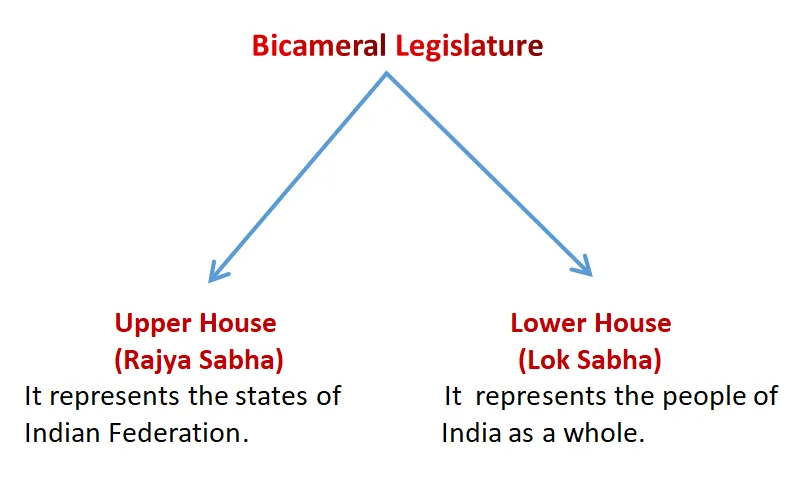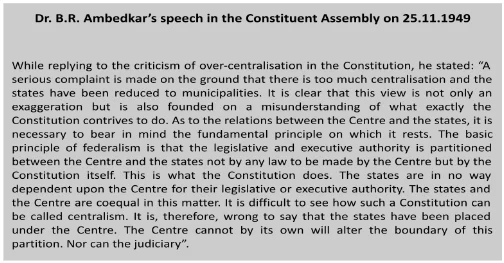The Indian Constitution blends federal and unitary features, creating a unique system that balances power between the central and state governments. It establishes a dual polity, with the Union and state governments handling different areas of governance. While maintaining a federal framework, the Constitution incorporates several unitary aspects to ensure national unity and effective central control.
Federal and Unitary Features of the Indian Constitution
The federal features of the Indian Constitution are explained below
- Dual Polity: The Indian Constitution establishes a dual polity which consists of the Union at the Centre and the States.
- The Union government at the centre deals with matters of national importance like defence, foreign affairs, currency, and so on.
- The state governments, on the other hand, deal with matters of regional and local importance like public order, agriculture, health, local government and so on.
- Written Constitution: The Indian Constitution is not only a written document but the lengthiest Constitution in the world.
- At present, it consists of a Preamble, about 470 Articles (divided into XXV Parts) and 12 Schedules.
- It prescribes the jurisdiction within which both the centre and state must perform functions.
- Division of Powers:

- Both the Centre and the states can make laws on the subjects of the concurrent list, but in case of a conflict, the law made by the centre prevails.
- The subjects which are not mentioned in any of the three lists (i.e. Residuary subjects) are given to the Centre.
Enroll now for UPSC Online Course
- Supremacy of the Constitution: The Constitution is the supreme law of the land.
- The laws enacted by the Centre and the states must conform to its provisions.
- The organs of the government such as legislative, executive and judicial at both levels must operate within the jurisdiction prescribed by the Constitution.
- Otherwise, they can be declared invalid through judicial review.
- Rigid Constitution: The Indian Constitution is rigid because the provisions which are concerned with the federal structure require special procedures for its amendment.
- Bicameralism: The Parliament of India is bicameral, consisting of the Rajya Sabha (Council of States) and the Lok Sabha (House of the People).
- The Rajya Sabha represents the states and union territories, while the Lok Sabha represents the people of India as a whole.

- Independent Judiciary: The Indian Constitution contains measures like security of tenure to judges, fixed service conditions etc., to make the judiciary independent of the government.
- It establishes an independent judiciary headed by the Supreme Court for two purposes:
- To protect the supremacy of the Constitution by exercising the power of judicial review, and
- To settle the disputes between the Centre and the States or between the States.
Unitary Features of The Constitution
Strong Centre: The division of powers is in favour of the Centre as
- The Union List of the seventh schedule contains more subjects than the State List.
- The Union List contains more important subjects.
- The Centre has overriding authority over the Concurrent List.
- The Centre has given residuary powers.

- Single Constitution: The Indian Constitution embodies not only the Constitution of the Centre but also those of the states.
- No Equality of State Representation: In India, the states are given representation in the Rajya Sabha on the basis of population.
- In the US, on the other hand, the principle of equality of representation of states in the Upper House is fully recognised, meaning equal representation irrespective of population.
- States Not Indestructible: Indian states have no right to territorial integrity.
- The Parliament can alone change the area, boundaries or name of any state.
- Hence, the Indian Federation can be referred to as “an indestructible Union of destructible states”.
- The American Federation, on the other hand, is “an indestructible Union of indestructible states”.
- Flexible Constitution: In the Indian Constitution the process of Constitutional amendment is less rigid than other federations.
- The bulk of the Constitutional provisions can be amended by the unilateral action of the Parliament, either by simple majority or by special majority.
- Further, only the Centre has the power to initiate an amendment to the Constitution.
- Emergency Provisions: During an emergency situation, the Centre becomes all-powerful and the states go into total control of the Central government.
- It converts the federal structure of the government into a unitary one without any formal amendment of the Constitution.
- Single Citizenship: The Indian Constitution embraced a single citizenship system, ensuring that all citizens, regardless of their birthplace or current residence, have equal rights throughout the entire country.
- Integrated Judiciary: The Constitution of India has instituted a unified judicial system, with the Supreme Court positioned at the apex.
- This singular court system is responsible for upholding both Central and state laws.
- All-India Services: In India, the Centre and the states have their separate public services.
- But, in addition to this, there are All-India Services (IAS, IPS, and IFS) which are common to both the Centre and the states.
- The members of these all-India services are recruited and trained by the Centre which also possesses ultimate control over them.
- Integrated Audit Machinery: The Comptroller and Auditor-General (CAG) of India audits the accounts of both the Central government and State Governments.
- However, his appointment and removal is done by the President without the states’ consultation.
- Governor’s Appointment: The Governor is appointed by the President and holds office during the pleasure of the President.
- He also acts as a representative of the Centre.
-
- Parliament’s Jurisdiction over the State List: The Parliament holds the authority to enact legislation on any matter listed under the State List if the Rajya Sabha passes a resolution to that effect in the national interest.
- Integrated Election Machinery: The Election Commission of India conducts elections to both the Central legislature and State legislatures.
- But, the States have no say in the Constitution of this body.
- The position of States is the same with regard to the removal of its members as well.
- Veto Over State Bills: The Governor has the authority to reserve specific categories of bills approved by the State legislature for the consideration of the President.
- The President can withhold approval for such bills not only initially but also upon re-submission.
| Federal Features of The Constitution | Unitary Features of The Constitution |
| Dual Polity | Strong Centre |
| Written Constitution | Single Constitution |
| Division of Powers | No Equality of State Representation |
| Supremacy of the Constitution | States Not Indestructible |
| Rigid Constitution | Flexibility of the Constitution |
| Bicameralism | Emergency Provisions |
| Independent Judiciary | Integrated Judiciary |
| Single Citizenship | |
| All-India Services |
Critical Evaluation of The Federal System
Views of Constitutional Experts on Indian Federalism: The Constitution of India has deviated from the various traditional federal systems like the US, Switzerland and Australia and incorporated a large number of unitary features, tilting the balance of power in favour of the Centre.
- Thus, many Constitutional experts have different views on the federal character of the Indian Constitution.
- K C Wheare described the Constitution of India as “quasi-federal”.
- K Santhanam mentioned two factors responsible for increasing the unitary bias (tendency of centralisation) of the Constitution. These are:
- The dominance of the Centre in financial matters and the reliance of the states upon the Central grants; and
- Influence of a robust former planning commission that directed developmental processes in the states.
- Morris Jones termed Indian federalism as a “bargaining federalism”.
- Ivor Jennings has referred to it as a “federation with a strong centralising tendency”.
- Dr. B.R. Ambedkar observed “The Constitution is a Federal Constitution in as much as it establishes a dual polity.
- The Union is not a league of states, united in a loose relationship, nor are the states the agencies of the Union, deriving powers from it.
- The Constitution creates both the Union and the states, both derive their respective authority from the Constitution.”

- S.R. Bommai v. Union of India case (1994): The Supreme Court laid down that the Constitution is federal and characterised federalism as the ‘Basic Structure of Indian Constitution.’
- Greater Authority of the Centre vs. State Independence: It was noted that within the framework of our Constitution, while the Centre is endowed with greater authority compared to the states, states are not mere extensions of the Centre.
- States’ Independent Constitutional Existence: States possess an independent Constitutional existence; they are not subordinate entities or representatives of the Centre.
- Within their designated sphere, states hold supreme authority.
- Emergency Powers and Federal Nature: The fact that during an emergency or certain other eventualities, the Centre may temporarily override states’ powers, but it does not negate the essential federal nature of the Constitution.
- These instances are exceptions and not the rule.
- Federalism as a Principled Stance: It is important to emphasise that federalism in the Indian Constitution is not a matter of administrative convenience but a principled stance—an outcome of our own Constitutional process and a recognition of the practical realities on the ground.
Enroll now for UPSC Online Course
- Compromise Between State Autonomy and Central Authority: Indian federalism represents a compromise between the following two conflicting considerations i.e. normal separation of powers under which states enjoy autonomy within their spheres, and the need for national integrity and a strong central government under exceptional circumstances.
| Must Read | |
| Current Affairs | Editorial Analysis |
| Upsc Notes | Upsc Blogs |
| NCERT Notes | Free Main Answer Writing |
Conclusion
Indian federalism is a pragmatic blend of autonomy and central authority, shaped by the country’s diverse needs and historical context.
- Despite its unitary features, the Constitution upholds the federal principle as essential to its structure.
- This balanced approach ensures both regional diversity and national coherence, reflecting a carefully crafted compromise in governance.
Sign up for the PWOnlyIAS Online Course by Physics Wallah and start your journey to IAS success today!
| Related Articles | |
| Federalism – Definition, Feature | Population in India |
| Preamble of the Indian Constitution | List of Union Council of Ministers 2024, Latest List! |

 GS Foundation
GS Foundation Optional Course
Optional Course Combo Courses
Combo Courses Degree Program
Degree Program












